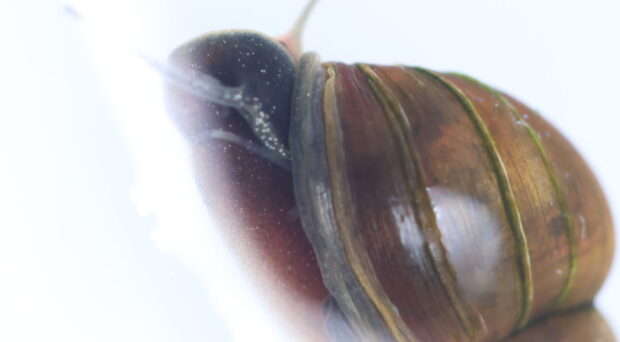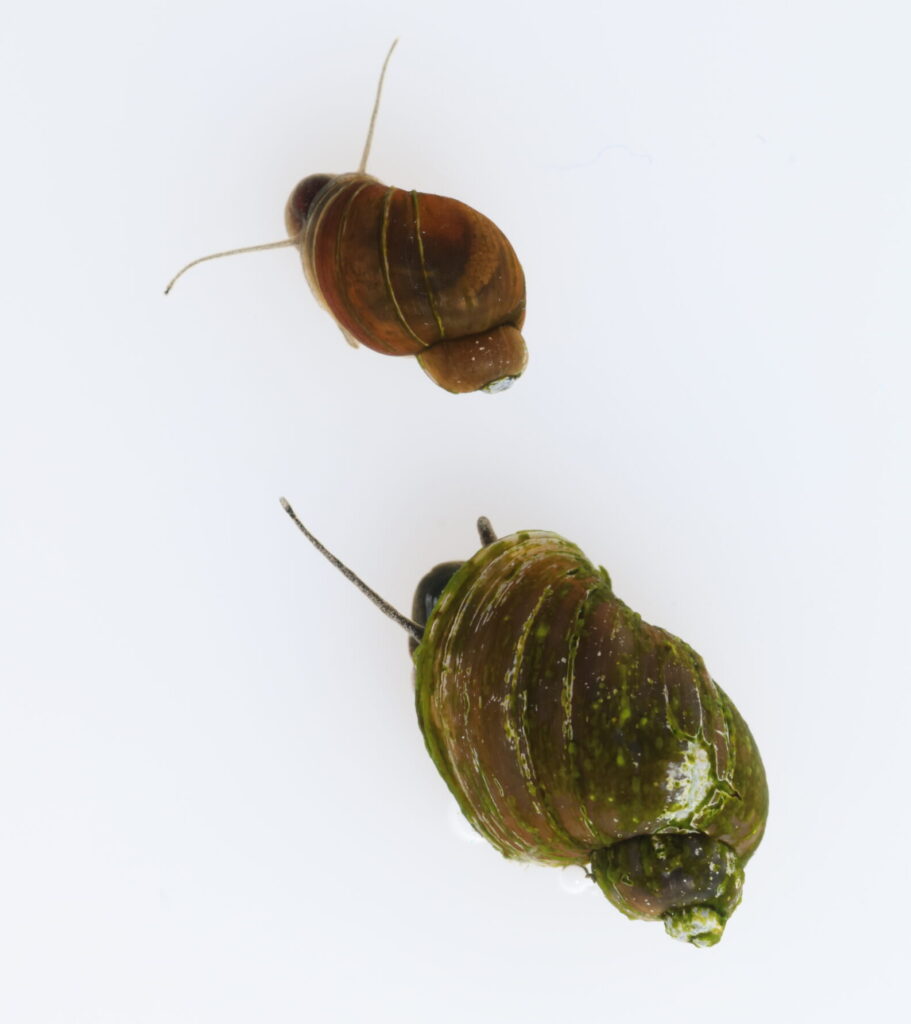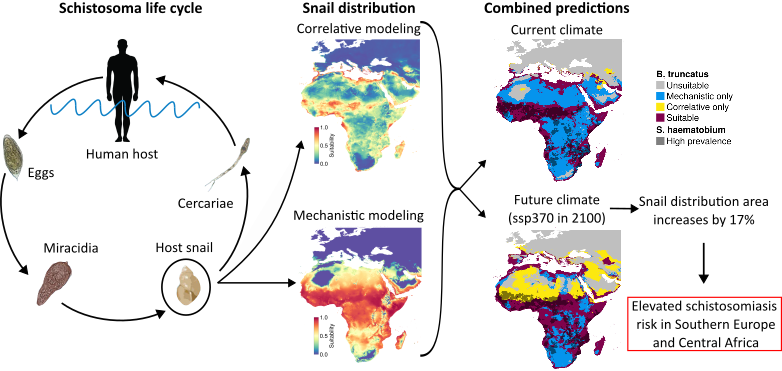
Bulinus truncatus, a hardy S. haematobium vector.
Bulinus truncatus is a small freshwater snail that made headlines across Europe in 2013, when an outbreak of the tropical parasitic disease schistosomiasis unexpectedly took place in Corsica. This was the first such outbreak on the European continent. Subsequent investigations showed that the strain of Schistosoma parasites found originated from Senegal. Infected travellers had released eggs into rivers through their urine, and the infection could spread through the B. truncatus snails already present.
In a recently published study, we map how climate change could change the distribution of this medically important, but neglected, snail species. Bulinus truncatus is a one of the main intermediate host species of the parasite Schistosoma haematobium, which causes urogenital schistosomiasis. This disease affects an estimated 150 million people, most of whom live in sub-Saharan Africa.
Climate change is a unique health hazard that can aggravate an incredibly wide variety of diseases, including more than half of all pathogens. However, vector-borne pathogens are particularly affected by climate change, because they spend a large chunk of their life cycle inside vectors. These vectors are typically small animals that are sensitive to changes in climatic conditions, such as mosquitoes, ticks, or snails.
Bulinus snails are such vectors, as S. haematobium parasites spend part of their lifecycle inside species of this genus. B. truncatus is a hardy animal that survives in hot and dry areas in Senegal and the Middle East, but also in temperate areas such as in Spain and in Corsica. We therefore thought it would be a likely candidate to spread schistosomiasis into new areas, and wanted to know how climate change would affect its distribution.

Combining modelling approaches.
Modellers use two distinct approaches when trying to make such predictions: correlative and mechanistic. In a correlative approach, predictions are based on an analysis of the climatic conditions in locations in which the organism has been found. Areas with similar conditions are presumed to be climatically suitable. Such models can reproduce complex dynamics, even without any knowledge about the biology of the organism. In a mechanistic approach, the organism itself is the starting point, and predictions are based on observations of the organism in similar conditions, often in a laboratory.
Both approaches have their upsides and limitations. In our study, we use both and interpret our results by comparing the predictions each model generates, to obtain more rigorous results.
Because of its combined approach, our study uses a wide variety of data about B. truncatus. The correlative model is calibrated with hundreds of geolocated observations of the species, while the mechanistic model is based on a dozen publications that describe experiments in which B. truncatus and its close relatives were exposed to a range of temperatures. All of this information is then combined with climate data to mark areas as climatically suitable or unsuitable.
The picture that emerges from our study is that most of Africa and the Middle East and slivers of Southern Europe already have temperatures that allow for the survival of B. truncatus, while the Sahel region and Western Africa are especially suitable.

In the future, however, this could change dramatically. On the one hand, large swathes of West Africa might become too warm for B. truncatus populations to survive, as shown especially by mechanistic modelling. On the other hand, the climate in Central Africa as well as Southern Europe will be more suitable, setting up these areas for new invasions by B. truncatus and unexpected outbreaks such as the recent one in Corsica.
Climate change scenarios.
We investigated the changing distribution of B. truncatus under two climate scenarios: SSP126 and SSP370.
- SSP126 represents a scenario where global efforts successfully limit warming to below 2°C, in line with the Paris Agreement goals.
- In contrast, SSP370 represents a scenario with moderate to high greenhouse gas emissions, leading to more significant warming.
Under both scenarios, our models predict similar changes up to the middle of the century (2041-2060). Under the SSP370 scenario, the predicted range shifts continue until the end of the century (2081-2100), while they stabilise under the SSP126 scenario. The net change in areas suitable for B. truncatus is 17% under the SSP370 scenario but can still be limited to 11% if greenhouse gas emissions are rapidly reduced as under the SSP126 scenario.
The use of models to predict the impacts of climate change on diseases has been heavily debated ever since the first such studies were performed in the 1990s. A number of studies have, like ours, projected increases risk of vector-borne diseases due to climate change, while others have pointed out that the burden of these diseases historically has declined, despite ongoing climate change.
Final thoughts.
We emphasise that the presence of vector snails is far from the only factor that determines the presence or absence of schistosomiasis. Measures such as snail control and water and hygiene infrastructure are crucial tools in schistosomiasis prevention and will remain so as the climate continues to change. Our study does show how climate change can change the habitat suitability for an important host snail, and thus indirectly the risk of schistosomiasis transmission across Africa and Europe. In areas that will be at increased risk due to climate change, traditional surveillance and control measures will become ever more important in the future.
This research was carried out as part of PREPARE4VBD, a multidisciplinary consortium with partners from across Africa and Europe that aims to predict and prepare for emerging vector-borne diseases. PREPARE4VBD is funded under the European Union’s Horizon 2020 programme. Read more: www.prepare4vbd.eu

Comments